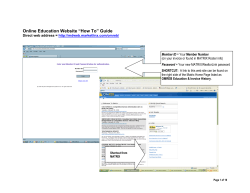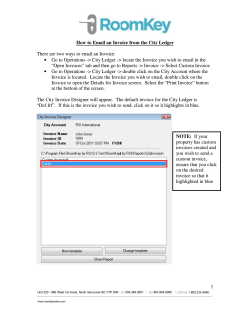
How to Best Match Invoices against Costs by 50%
White Paper How to Best Match Invoices against Purchases - and Drive Down A/P Costs by 50% February 2010 Seven Steps to Think About Before Starting the Process Automation Project Article by Rowan Lemley Product Marketing Manager at Basware Corporation rowan.lemley@basware.com Tuomo Peltonen Chief Solution Architect at Basware Corporation tuomo.peltonen@basware.com © Basware Corporation 2010 | www.basware.com Introduction Everyone knows that manual handling of invoices is both time-consuming and expensive. Invoices get lost or there are duplicate invoices that are hard to spot, approval processes are long and all in all the manual workflow makes it difficult to track the whereabouts of the invoices. Even though the actual purchase orders existed, manually matching can turn out to be really difficult and usually results in unnecessary approval rounds and inquiries to complete some missing information. In today’s economy, companies are actively looking for new and sensible cost cutting opportunities and it is only natural that the laborious, error-prone manual invoice processing is seen as one of them. By introducing a fully electronic workflow and optimizing the process by matching the approved orders with incoming invoices, the companies can immediately begin to realize A/P cost savings. Though the goal of matching orders to invoices may seem simple enough, the actual process automation along with associated change management issues will always require focus and effort. One of the biggest changes that can be made will be to improve communication and collaboration between finance and procurement and this issue often represents a large ‘cultural’ change in the organization. However, as organizations come to realize the bottom-line benefits ARE worth the effort, they will be more likely to embrace the changes and make the necessary investments. To make this effort as painless as possible, we have put together a simple checklist with the key elements to be covered prior to diving into an A/P automation project. 1 Understand the goals of automation – Know the number of PO and non-PO invoices/FTE/year You can eventually automate processing of both of these invoice categories, but you’ll get best results by automating first the invoices that most burden your staff. Assuming you have a purchasing system(s) and there are purchase orders to match invoices against, starting here will yield the biggest win with the least effort. The next step towards full automation would look to your ‘orderless’ invoices. Invoices that do not relate to purchase orders are typically a minority of the total invoice volume but significant in terms of the effort required to process. Accounting for between 10-45% of total invoice volumes, orderless invoices often relate to cost items such as rent, leasing, services, telecoms, utilities etc. Finding these invoices is fairly straightforward for any company using Basware Invoice Automation. Running basic reports from the system will quickly provide a list of suppliers sending you invoices which are candidates for automation. Start by matching the invoices that most burden your staff. Do a quick comparison. Invoices that have purchase orders (POs) Number of these invoices/FTE/year is Invoices without POs Number of these invoices/FTE/year is © Basware Corporation 2010 | www.basware.com 2 2 Consider full vs. gradual automation Full automation can mean 100% straight-through-processing for all of your invoices but in most cases this is not possible for a variety of reasons. The most typically sighted reason is that companies prefer a measure of oversight during key parts of the invoice handling process. It’s not that they don’t trust the technology to do the job; it’s more that human eyes see things that software cannot recognize as meaningful. For example, perhaps purchasing policy demands that every approved invoice must have a comment (explanation) included. A business rule can easily ensure that there is a comment but only a person could ensure that the comment is meaningful by reading it. Prioritize the parts of the invoice processing you wish to automate through matching. Identify the parts where you want to maintain manual control. 3 Document the A/P process to identify your solution requirements and key stakeholders Document your A/P process and the functions you think you will need. For instance, if you need to know which items in stock have been invoiced, the invoices should be matched upon goods receipt and matching would use line level information from both the PO and the invoice. Create exception management workflows. Document the different units within the organization you will need to inform on possible discrepancies. For instance, you can agree that the procurement department will handle all quantity related discrepancies. Involve both procurement and suppliers to improve the process. See the automation as an opportunity to develop both A/P and procurement processes. Connect with your buyers and ask them to involve also the suppliers. After all, the suppliers should be happy to help you to pay them faster. Involve also procurement and suppliers to improve the A/P process. Create exception management workflows for handling discrepancies. 4 Consolidate data from your PO and ERP systems – It is possible! Your processing solution should give you one central access to all your POs and invoices, but still be easily integrated with your other business systems or multiple ERPs. It is crucial that your solution won’t be affected by possible ERP version changes. © Basware Corporation 2010 | www.basware.com 3 5 You may need to compromise on data accuracy to achieve the best PO/invoice matching results The 100% matching success is seldom what the organizations truly want to achieve. What they are after is 100% control. None of the invoices that are missing some crucial data should be processed straight-through, even though it would mean 0% matching result in the beginning. On the other hand, the invoices passing the control would be 100% validated and would not need any manual intervention. The order/invoice matching levels can vary according to company’s internal purchase categories and specific suppliers. The amount of invoice data you wish to validate often helps you to choose the matching level that best works for you. Line level matching • Best data accuracy and control given the high amount of data that needs to be validated before matching succeeds • When more data needs to be validated, there is also a higher probability that some of it is incorrect. Consequently, the matching is likely to fail more often • Helps to identify the root causes for the incorrect data Header-level matching • Checks the invoice amount, supplier and currency, ensuring that you’ll pay the correct amount to the correct supplier The decision to go with either header level or line level matching or to have a mix will be crucial for how well the system actually does what it needs to do – i.e. gives you the highest rates of automation where you want it, with the best control over the whole process. It is important to understand that the matching success can only be improved by identifying and fixing the root causes for the incorrect data (for instance, by enhancing the data capture, by communicating with the supplier or even by changing the supplier). 6 Ensure management buy-in Automated invoice processing can deliver up to 50% cost savings within only few months. Your CFO should also find interesting that matching orders against invoices truly improves working capital management and can even release cash through active deployment of early-payment discounts. Ask your solution partner to help you put together a business case and to demonstrate the targeted cost savings and process improvements. © Basware Corporation 2010 | www.basware.com 4 7 Ensure smooth implementation and eventual process acceptance Complex processes are challenging to implement, but even the most complicated processes can be automated. Automate the process piece by piece. By automating first the most common tasks you can cut off most of the routine manual work. Be sure to communicate the benefits to ensure both management and end-user buy-in. Communicate the Benefits • Quick and easy audits as all the data is in one place • Electronic information flow between departments and units with a full audit trail • Staff can focus on more strategic and rewarding tasks • Automatic matching enables faster payments and completely eliminates duplicate payments and late-payment penalties © Basware Corporation 2010 | www.basware.com 5 Trademarks The Basware name and the Basware logo are trademarks of Basware Corporation. Basware Purchase Management, Basware Invoice Processing, Basware Document Archiving and Basware Business Transactions are trademarks of Basware Corporation. * All third party trademarks are property of their respective owner. Copyright © Copyright 2010 Basware Corporation. The copyright of this document is vested in Basware Corporation. No part of this document may be reproduced, translated or transmitted in any form or by any means, electronic or mechanical, for any purpose without the express written permission of Basware Corporation, and then only on the condition that this notice is included in any such reproduction. No information as to the contents of this document may be communicated to any third party without the prior written consent of Basware Corporation. Disclaimer Information in this document is subject to change without notice and does not represent a commitment on Basware Corporation. Basware Corporation is not liable for errors contained in this document or for incidental or consequential damages in connection with furnishing or use of this material. Basware products are protected by the USA and international copyright laws. Basware Corporation Address: Linnoitustie 2 Cello Building FIN-Espoo Finland Postal address: P.O. Box 97 FIN-02601 Espoo Finland www.basware.com © Basware Corporation 2010 | www.basware.com 6
© Copyright 2025










